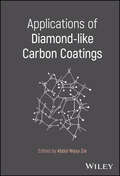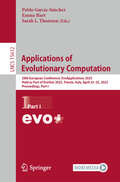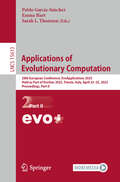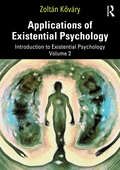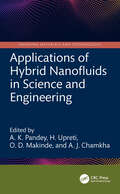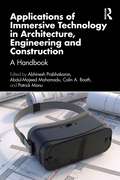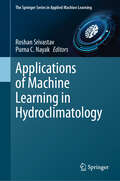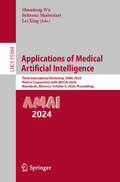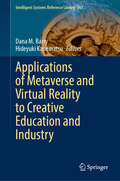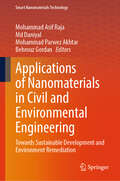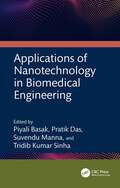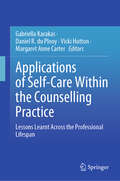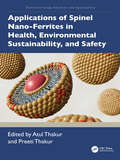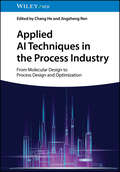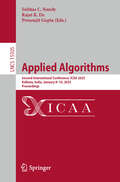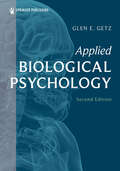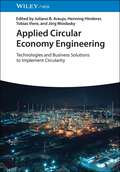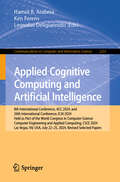- Table View
- List View
Applications of Computational Tools in Drug Design and Development
by S. N. Koteswara Rao G. Rajasekhar Reddy AlavalaThis book provides a comprehensive overview of the role of computers and computational tools at different stages of drug discovery and development. Designed to meet the needs of a beginner to advanced learner, the book provides the information on the tools, how they work, with the latest reports on applications in drug design, drug delivery and building network pharmacology models. Part I explores the pharmacological aspects, covering computational simulation of drug delivery at the molecular level, modeling for formulation design, and the revolutionary use of computational fluid dynamics in pharmaceutical processes. Specific applications such as pharmaceutical die filling processes, inhalation aerosol-based targeted drug delivery, and the development of inhalation compounds using in silico modeling tools are discussed. The use of computational tools in cheminformatics and their application in preformulation perspectives for drug delivery are also included. Part II expands the scope to include solubility prediction, absorption prediction, protein binding prediction, bio-permeability prediction, toxicity prediction, and metabolism prediction. It covers the identification of potential sites of metabolism in lead molecules and computer-assisted simulation studies to understand drug-polymer interactions. Recent advances in drug likeness screening using software and online tools are also reviewed. Part III focuses on specific therapeutic areas. <span class=
Applications of Diamond-like Carbon Coatings
by Abdul Wasy ZiaAn incisive guide to diamond-like carbon (DLC) coatings and their contemporary applications In Applications of Diamond-like Carbon Coatings, distinguished researcher Dr. Abdul Wasy Zia delivers an insightful and up-to-date discussion of the latest advancements in new and non-conventional applications of diamond-like carbon (DLC) coatings. The editor explains the transformation of typical topics into advanced applications of DLC, including tribology for future transportation solutions, green lubrication, invasive implants, MEMS, optical devices, and more. The book also details advanced and contemporary trends in DLC coatings, like material informatics involving artificial intelligence and machine learning, and new, net-zero applications, including energy storage batteries. Readers will also find: A thorough introduction to applications of DLC coatings in mechanics, transportation, medicine, and electrical and optical device manufacture Comprehensive explorations of emerging trends in DLC coatings, including green energy, data-centric approaches, textile and plastics, and carbon circularity from DLC coated productsPractical discussions of how small and medium industries can design and develop DLC coatings for broad engineering applications Complete treatments of the benefits and opportunities presented by DLC coating applications Perfect for postgraduate students and researchers with an interest in DLC coatings, Applications of Diamond-like Carbon Coatings will also benefit scholars and instructors in academia, technical managers, scientists, engineers, and corporate research and development professionals with backgrounds in chemistry, materials science, polymer chemistry, and physical chemistry.
Applications of Digital Twins and Robotics in the Construction Sector
by Syed Saad Syed Ammad Kumeel RasheedThis book provides insights to the lay person as well as the experts who are actively enabling these changes in the construction industry. The book explores digital twins and robots in the construction sector, and how they are revolutionizing this field. It comprises chapters that begin with the basics before going upstream. Digital Twins are important in the planning and design of projects where, real-time simulation, visualization and data-driven decision-making are done. Furthermore, robotics play a significant role in on-site execution, thus automating construction operations, and guaranteeing accuracy and safety. The book discusses the harmony of digital twinning and robotics, showing that these two are complementary with regard to enhancing efficiencies on-site, in monitoring progress and live control.Applications of Digital Twins and Robotics in the Construction Sector covers the current applications of these technologies and forecasts future applications, exposing readers to breakthrough innovations transforming this field. It aims inform all readers, expert or simply interested and inquisitive about digital twins and construction robots’ transformation.
Applications of Evolutionary Computation: 28th European Conference, EvoApplications 2025, Held as Part of EvoStar 2025, Trieste, Italy, April 23–25, 2025, Proceedings, Part I (Lecture Notes in Computer Science #15612)
by Sarah L. Thomson Emma Hart Pablo García-SánchezThis two-volume set, LNCS 15612 and 15613 constitutes the refereed proceedings of the 28th European Conference on Applications of Evolutionary Computation, EvoApplications 2025, held as part of EvoStar 2025, in Trieste, Italy, during April 23–25, 2025, and co-located with the EvoStar events, EvoCOP, EvoMUSART, and EuroGP. The 50 full papers and 18 short papers presented in this book were carefully reviewed and selected from 104 submissions. These papers have been organized in the following topical sections: Part I: EvoApplications.Part II: Evolutionary machine learning; 30 years of particle swarm optimisation; Analysis of Evolutionary Computation Methods: Theory, Empirics, and Real-World Applications; Bio-inspired Algorithms for Green Computing and Sustainable Complex Systems; Computational Intelligence for Sustainability; EvoLLMs (Integrating Evolutionary Computing with Large Language Models (LLMs); Evolutionary Computation in Edge, Fog, and Cloud Computing; Evolutionary Computation in Image Analysis, Signal Processing, and Pattern Recognition; Machine Learning and AI in Digital Healthcare and Personalized Medicine; Soft Computing Applied to Games.
Applications of Evolutionary Computation: 28th European Conference, EvoApplications 2025, Held as Part of EvoStar 2025, Trieste, Italy, April 23–25, 2025, Proceedings, Part II (Lecture Notes in Computer Science #15613)
by Sarah L. Thomson Emma Hart Pablo García-SánchezThis two-volume set, LNCS 15612 and 15613 constitutes the refereed proceedings of the 28th European Conference on Applications of Evolutionary Computation, EvoApplications 2025, held as part of EvoStar 2025, in Trieste, Italy, during April 23–25, 2025, and co-located with the EvoStar events, EvoCOP, EvoMUSART, and EuroGP. The 50 full papers and 18 short papers presented in this book were carefully reviewed and selected from 104 submissions. These papers have been organized in the following topical sections: Part I: EvoApplications.Part II: Evolutionary machine learning; 30 years of particle swarm optimisation; Analysis of Evolutionary Computation Methods: Theory, Empirics, and Real-World Applications; Bio-inspired Algorithms for Green Computing and Sustainable Complex Systems; Computational Intelligence for Sustainability; EvoLLMs (Integrating Evolutionary Computing with Large Language Models (LLMs); Evolutionary Computation in Edge, Fog, and Cloud Computing; Evolutionary Computation in Image Analysis, Signal Processing, and Pattern Recognition; Machine Learning and AI in Digital Healthcare and Personalized Medicine; Soft Computing Applied to Games.
Applications of Existential Psychology: Introduction to Existential Psychology Volume 2
by Zoltán KőváryThe second in a two-part set, this volume offers a detailed examination of the application of existential psychology.This book begins by looking at the "conditio humana" – the most important topics of existential psychology, including anxiety, freedom, choices, authenticity, suffering and meaning, creativity, togetherness, time and death. It then moves through the practical application of existential psychology in the context of dreams, research, pathology and therapy. Examining key theories, models and research, the volume offers a fascinating overview of how the disciplines of art, philosophy, literature, science and theology contribute to a deeper understanding of personal self-knowledge and a person’s sense of purpose. This unique transdisciplinary approach demonstrates how readers can apply philosophical, historical and artistic aspects of existential psychology to their lives. The book concludes by considering the role of existential psychology in the present.Going beyond the questions of therapy and counselling that typically make up the study of existential psychology, the book offers the ultimate introduction for students and scholars of this fascinating and deeply rooted discipline. It may also interest professionals working in related fields.
Applications of Fuzzy Logic in Decision Making and Management Science (Information Systems Engineering and Management #29)
by Subrata Jana Anirban Sarkar Biswadip Basu Mallik Chiranjibe JanaThe fuzzy logic theory is a branch of mathematics dealing with uncertainty in measurement of any quantity or any estimation. The concept of fuzzy logic uses membership functions. The range of values from various functions or operations determines their construction. A defined rules set can create an application process and membership controls. Fuzzy applications include control system engineering, image processing, power engineering, industrial automation, robotics, consumer electronics and AI. Artificial intelligence, machine learning and expert systems have various applications that address complicated issues. The fuzzy logic inference rules have solved many problems in manufacturing and other industries. Auto engines by Honda, lift control by Mitsubishi Electric, palmtop computers by Hitachi, dishwashers by Matsushita and anti-lock brakes by Nissan are examples of corporations using machine-learning techniques with fuzzy principles. Fuzzy approaches and rule sets interpret computer vision, machine learning and evolution. Fuzzy sets can govern decision rules. Several areas use fuzzy systems in different ways. Computer vision, image processing and meta heuristic evolutionary computing are typical face research applications. Fuzzy theories can optimise and fine-tune the classifier model. Fuzzy theory is used in management, stock market analysis, information retrieval, linguistics, and behavioural science with good results. Fuzzy applications are seen in data mining and stock market prediction. The fuzzy machine learning model in the ensemble pattern accurately classifies and predicts all kinds of tasks. Fuzzy theories help maintain high accuracy. For categorisation and prediction, the ensemble pattern uses fuzzy concepts. The constant growth of fuzzy domain leads to several categorisation and prediction methods. Fuzzy type 2 and intuitionistic fuzzy logic exhibit promise accuracy and versatility. Such fuzzy logic variations can readily overcome the drawbacks of the simple fuzzy model. The book has been developed keeping in view about readers of different categories starting from the students to the professionals and researchers as well. The development of the book and its content layout will be done so meticulously proving the enough insights of the subjects to the readers so that the readers can easily pursue their research concept from the book. Overall the book serve as the purpose of repository of good amount of information and their technical presentations.
Applications of Hybrid Nanofluids in Science and Engineering (Emerging Materials and Technologies)
by O. D. Makinde A. K. Pandey H. Upreti A. J. ChamkhaApplications of Hybrid Nanofluids in Science and Engineering delves deep into the multifaceted realms in which these dynamic fluids are playing a pivotal role in various fields.This comprehensive volume elucidates the diverse applications and promising potentials of hybrid nanofluids. It introduces hybrid nanofluids and their preparation methods, thermophysical properties, advantages, applications, and future scope. Models to compute the effective thermophysical properties of hybrid nanofluids are also discussed, along with their limitations. In the application section, mathematical models are formulated to contemplate the flow of hybrid nanofluids through different surfaces/geometries under different situations. Also, the entropy generation minimization in hybrid nanofluid flow is discussed with its application in refrigeration, power generation, and other processes.The subject matter in this book will enable the reader to do the following: Learn the ins and outs of hybrid nanofluids—from how they are made to the special characteristics they embody Explore hybrid nanofluids' potential in thermal management, energy systems, materials science, biomedical engineering, and more Use advanced computational and analytical methods to analyse complex fluid dynamics models Anticipate the impact of hybrid nanofluid research on upcoming sectors like renewable energy and innovative manufacturing This book is aimed at researchers and graduate students in mechanical and chemical engineering and materials science.
Applications of Immersive Technology in Architecture, Engineering and Construction: A Handbook (Spon Research)
by Colin A. Booth Patrick Manu Abdul-Majeed Mahamadu Abhinesh PrabhakaranThis edited book addresses a gap in literature by advancing current understandings of the applications of immersive technology within the architecture, engineering and construction (AEC) sector.Globally, the architecture, engineering and construction (AEC) sector makes an enormous contribution to the socio-economic development of nations, which is primarily evidenced by its creation/provision of the built environment. The sector has, however, often been criticised for inefficiencies, waste and diverse forms of adverse impacts that are associated with the lifecycle of the provision of built assets – design, construction, operations and maintenance and end-of-life phases. Over the years, the inefficiencies, waste and adverse impacts have often been a catalyst for calls and initiatives to transform the AEC sector. The advent of the fourth industrial revolution (commonly referred to as, ‘Industry 4.0’), which entails the automation and digitalisation of production, presents opportunities to leverage emerging technologies to improve the image and productivity of the sector. Prominent among the emerging technologies in the Industry 4.0 era is that of immersive technology, which includes virtual reality, mixed reality and augmented reality. The capability of immersive technology to deliver beneficial impacts for multiple construction sector stakeholders throughout the construction lifecycle has been acknowledged within the industry and this continues to stimulate interest amongst practitioners, policymakers and researchers. Despite this phenomenon, at present there is no dedicated compendium of research-informed text that focusses on the multifaceted applications of immersive technology throughout the lifecycle of the provision of built assets right from concept design to end-of-life.This book thus addresses this gap in literature by advancing current understanding of the applications of immersive technology within the AEC industry. Readers will understand how the technologies are applied, the resulting array of impacts including benefits, drawbacks, challenges and future directions for applications, research and development.
Applications of Machine Learning in Hydroclimatology (The Springer Series in Applied Machine Learning)
by Roshan Srivastav Purna C. NayakApplications of Machine Learning in Hydroclimatology is a comprehensive exploration of the transformative potential of machine learning for addressing critical challenges in water resources management. The book explores how artificial intelligence can unravel the complexities of hydrological systems, providing researchers and practitioners with cutting-edge tools to model, predict, and manage these systems with greater precision and effectiveness. It thoroughly examines the modeling of hydrometeorological extremes, such as floods and droughts, which are becoming increasingly difficult to predict due to climate change. By leveraging AI-driven methods to forecast these extremes, the book offers innovative approaches that enhance predictive accuracy. It emphasizes the importance of analyzing non-stationarity and uncertainty in a rapidly evolving climate landscape, illustrating how statistical and frequency analyses can improve hydrological forecasts. Moreover, the book explores the impact of climate change on flood risks, drought occurrences, and reservoir operations, providing insights into how these phenomena affect water resource management. To provide practical solutions, the book includes case studies that showcase effective mitigation measures for water-related challenges. These examples highlight the use of machine learning techniques such as deep learning, reinforcement learning, and statistical downscaling in real-world scenarios. They demonstrate how artificial intelligence can optimize decision-making and resource management while improving our understanding of complex hydrological phenomena. By utilizing machine learning architectures tailored to hydrology, the book presents physics-guided models, data-driven techniques, and hybrid approaches that can be used to address water management issues. Ultimately, Applications of Machine Learning in Hydroclimatology empowers researchers, practitioners, and policymakers to harness machine learning for sustainable water management. It bridges the gap between advanced AI technologies and hydrological science, offering innovative solutions to tackle today's most pressing challenges in water resources.
Applications of Mathematics in Science and Technology
by R. Senthil Kumar Bui Thanh Hung M. Sekar Ayhan EsiThe Conference dealt with one of the most important problems faced in International development in Pure Mathematics and Applied mathematics development in engineering such as Cryptography, Cyber Security, Network, Operations Research, Heat Equation and so forth. The aim of the conference was to provide a platform for researchers, engineers, academicians, as well as industrial professionals, to present their research results and development activities in Pure and Apply Mathematics, and its applied technology. It provided opportunities for the delegates to exchange new ideas and application experiences, to establish business or research relations and to find global partners for future collaboration.
Applications of Medical Artificial Intelligence: Third International Workshop, AMAI 2024, Held in Conjunction with MICCAI 2024, Marrakesh, Morocco, October 6, 2024, Proceedings (Lecture Notes in Computer Science #15384)
by Lei Xing Shandong Wu Behrouz ShabestariThis book constitutes the refereed proceedings of the Third International Workshop on Applications of Medical Artificial Intelligence, AMAI 2024, held in conjunction with MICCAI 2024, in Marrakesh, Morocco on October 6th, 2024. The volume includes 24 papers which were carefully reviewed and selected from 59 submissions. The AMAI 2024 workshop created a forum to bring together researchers, clinicians, domain experts, AI practitioners, industry representatives, and students to investigate and discuss various challenges and opportunities related to applications of medical AI.
Applications of Metaverse and Virtual Reality to Creative Education and Industry (Intelligent Systems Reference Library #267)
by Hideyuki Kanematsu Dana M. BarryThis book provides excellent examples of metaverse and virtual reality and their unlimited possibilities for education and industry. By examining innovative educational activities in both real and virtual worlds, such as Second Life, SL (a three-dimensional world where avatars perform specific tasks on behalf of us), we get a unique perspective on how these technologies can revolutionize learning and professional practices. Metaverse offers a fully immersive and interconnected virtual environment, enabling individuals to engage in digital experiences that closely resemble real-world interactions, thereby providing limitless possibilities for education and industry. In addition, the chapters cover various key topics, including the integration of virtual reality in creative game design, the use of VR (virtual reality) headsets with sensor glasses for physiological data collection, and the application of VR in fields like architecture and medical education. Artificial Intelligence, Robotics, and Machine Learning (along with other related fields) are also mentioned. In addition, readers will encounter discussions about the future fusion of real and virtual worlds, highlighting the role of Digital Twin Technology and Augmented Reality. The book invites readers to consider critical questions about the implications of these technologies for society and industry. This book is a must-read for students, educators, engineers, and researchers interested in the cutting-edge applications of virtual reality and the metaverse. It serves as a textbook, reference, and practical guide, making it invaluable for academic audiences and professionals seeking to harness the power of these technologies for innovative solutions. Whether you are a professor, scientist, or engineer, or simply curious about the metaverse, avatars, and virtual reality, this book promises to be a rewarding journey into the limitless potential of these technologies for creative education and industry.
Applications of Nanomaterials in Civil and Environmental Engineering: Towards Sustainable Development and Environment Remediation (Smart Nanomaterials Technology)
by Mohammad Asif Raja Md Daniyal Mohammad Parwez Akhtar Behrouz GordanThis book explores the transformative use of nanomaterials in civil engineering, emphasizing sustainability and innovation in addressing enduring challenges. It covers the enhancement of construction materials, including cementitious composites, coatings, and structural components with nanomaterials to improve corrosion resistance, mechanical properties, and cement performance. The integration of nanotechnology with Industry 4.0 and digital twins is also discussed, promoting smarter engineering practices. Additionally, it details the applications of nanomaterials in pavement construction and soil property enhancement for seismic resilience. It addresses soil stabilization, slope stability, ground improvement, and scour protection for waterfront infrastructure. Furthermore, it delves into environmental engineering applications such as advanced wastewater treatment, soil remediation, and air quality improvement through nanotechnology. This book features seventeen chapters by leading experts, offering research insights and practical guidance for sustainable infrastructure and environmental solutions.
Applications of Nanotechnology in Biomedical Engineering
by Suvendu Manna Piyali Basak Pratik Das Tridib Kumar SinhaThis book presents recent advancements in nanotechnology-based innovations in the biomedical sciences and engineering fields, including nanoimaging, nano-delivery of drugs and genes, antimicrobial and antiviral coatings, nano-neutraceuticals, and nano-cosmetics. It covers a wide range of topics, which include nanosensors, nano-based coatings, and wound healing, as well as scope for new research and development. It is a guide to the state-of-the-art nanotechnological advancements in medical image processing and disease detection. Features are as follows: Covers industry-oriented applications of nanomaterials in the field of biomedical engineering Discusses development of nature-inspired nano-engineered nutraceuticals Reviews research on nano-coating to restrict biofilm formation and nosocomial infections Includes different aspects of both medical sciences and health sciences, ranging from medical imaging to cosmetics Explores micro-/nano-SMART devices for biomedical applications This book is aimed at researchers and graduate students in biomedical engineering, nanotechnology, and related areas.
Applications of Self-Care Within the Counselling Practice: Lessons Learnt Across the Professional Lifespan
by Margaret Anne Carter Vicki Hutton Gabriella Karakas Daniel R. du PlooyThis volume presents counsellors' self-care journeys across all stages of the professional lifespan—early career, mid-career, and tenured professional. Each chapter presents a contributor's personal reflection and insight on sustaining oneself in the field through a strengths-based, autoethnographic lens. Addressing challenges like burnout, structural barriers, and global events (e.g., pandemics, natural disasters, and human rights movements), the collection highlights the realities of balancing self-care while supporting others. Although all affiliated with ACAP University College, the contributors bring unique perspectives shaped by personal experiences—such as motherhood, caregiving, grief, and cultural contexts—and professional backgrounds in clinical psychology, research, allied health, trauma-informed care, and multidisciplinary practice. Aimed at inspiring emerging counsellors and students while offering insights to seasoned professionals, this volume provides practical strategies on how resilience and longevity can be supported across the counselling profession.
Applications of Spinel Nano-Ferrites in Health, Environmental Sustainability, and Safety (Nanotechnology Advances and Applications)
by Atul Thakur Preeti ThakurThis book presents the foundational concepts of spinel nano-ferrites, their synthesis techniques, and their cutting-edge applications in various fields. The book begins with an introduction to spinel nano-ferrites, discussing their unique properties and historical context. It then delves into various synthesis techniques, such as sol-gel methods, co-precipitation, and hydrothermal processes, highlighting the influence of these methods on the resultant structures and morphologies. The book also reviews the electrical and magnetic characteristics of spinel nano-ferrites, demonstrating their potential in electronic and magnetic devices. The role of spinel nano-ferrites in the health sector is explored in depth, detailing their use as antibacterial and antifungal agents and their innovative applications in magnetic resonance imaging (MRI), cancer detection, targeted drug delivery, and hyperthermia treatment. The chapters further examine the environmental applications of spinel nano-ferrites, including their effectiveness in pollution remediation, water purification, dye degradation, and the detection and removal of heavy metal ions and microplastics from wastewater. Toward the end, the book explores the development of gas sensors and humidity sensors using spinel nano-ferrites, as well as devices designed for human and environmental safety. This book is intended for researchers and students of nanotechnology, nanobiotechnology, healthcare professionals, and environmental scientists.Key Features: Covers foundational concepts, unique properties, and cutting-edge applications of spinel nano-ferrites Explores various synthesis methods such as sol-gel, co-precipitation, and hydrothermal processes, and their impact on structures and morphologies of spinel nano-ferrites Discusses the electrical and magnetic characteristics of spinel nano-ferrites Examines the potential of spinel nano-ferrites as antibacterial and antifungal agents, and their roles in MRI, cancer detection, and drug delivery Highlights the effectiveness of spinel nano-ferrites in pollution remediation, water purification, and dye degradation
Applied AI Techniques in the Process Industry: From Molecular Design to Process Design and Optimization
by Jingzheng Ren Chang HeThorough discussion of data-driven and first principles models for energy-relevant systems and processes, approached through various in-depth case studies Applied AI Techniques in the Process Industry identifies and categorizes the various hybrid models available that integrate data-driven models for energy-relevant systems and processes with different forms of process knowledge and domain expertise. State-of-the-art techniques such as reduced-order modeling, sparse identification, and physics-informed neural networks are comprehensively summarized, along with their benefits, such as improved interpretability and predictive power. Numerous in-depth case studies regarding the covered models and methods for data-driven modeling, process optimization, and machine learning are presented, from screening high-performance ionic liquids and AI-assisted drug design to designing heat exchangers with physics-informed deep learning. Edited by two highly qualified academics and contributed to by a number of leading experts in the field, Applied AI Techniques in the Process Industry includes information on: Integration of observed data and reaction mechanisms in deep learning for designing sustainable glycolic acidMachine learning-aided rational screening of task-specific ionic liquids and AI for property modeling and solvent tailoringIntegration of incomplete prior knowledge into data-driven inferential sensor models under the variational Bayesian frameworkAI-aided high-throughput screening, optimistic design of MOF materials for adsorptive gas separation, and reduced-order modeling and optimization of cooling tower systemsSurrogate modeling for accelerating optimization of complex systems in chemical engineering Applied AI Techniques in the Process Industry is an essential reference on the subject for process, chemical, and pharmaceutical engineers seeking to improve physical interpretability in data-driven models to enable usage that scales with a system and reduce inaccuracies and mismatch issues.
Applied Algorithms: Second International Conference, ICAA 2025, Kolkata, India, January 8–10, 2025, Proceedings (Lecture Notes in Computer Science #15505)
by Rajat K. De Prosenjit Gupta Subhas C. NandyThis book LNCS constitutes the refereed proceedings of the Second International Conference on Applied Algorithms, ICAA 2025, held in Kolkata, India, during January 8–10, 2025. The 26 full papers and 4 short papers are carefully reviewed and selected from 93 submissions. This conference sought original contributions related to the design, analysis, implementation, and experimental evaluation of efficient algorithms and data structures for problems.
Applied Antifragility in Natural Systems: From Principles to Applications (SpringerBriefs in Computer Science)
by Roman Bauer Cristian Axenie Oliver López Corona Jeffrey WestAs coined in the book of Nassim Taleb, antifragility is a property of a system to gain from uncertainty, randomness, and volatility, opposite to what fragility would incur. An antifragile system’s response to external perturbations is beyond robust, such that small stressors can strengthen the future response of the system by adding a strong anticipation component. Such principles are already well suited for describing behaviors in natural systems but also in approaching therapy designs and eco-system modelling and eco-system analysis. The purpose of this book is to build a foundational knowledge base by applying antifragile system design, analysis, and development in natural systems, including biomedicine, neuroscience, and ecology as main fields. We are interested in formalizing principles and an apparatus that turns the basic concept of antifragility into a tool for designing and building closed-loop systems that behave beyond robust in the face of uncertainty when characterizing and intervening in biomedical and ecological (eco)systems. The book introduces the framework of applied antifragility and possible paths to build systems that gain from uncertainty. We draw from the body of literature on natural systems (e.g. cancer therapy, antibiotics, neuroscience, and agricultural pest management) in an attempt to unify the scales of antifragility in one framework. The work of the Applied Antifragility Group in oncology, neuroscience, and ecology led by the authors provides a good overview on the current research status.
Applied Artificial Intelligence 4: The Third Serbian International Conference on Applied Artificial Intelligence (SICAAI) (Lecture Notes in Networks and Systems #1446)
by Nenad FilipovićThe book covers the state-of-the-art research knowledge and results on the innovative theories, methodology and applications of artificial intelligence and its sub-domain like deep learning in different areas such as medicine, economy, education, law, smart city, government, industry etc. Moreover, the book aims to provide a platform for researchers and practitioners for both academia and industry to share the information about cutting-edge developments in the field of artificial intelligence. The chapters in this book integrated approach toward global exchange of information on technological advances, scientific innovations and the effectiveness of various regulatory programs toward AI application in medicine, biology, chemistry, financial, games, law and engineering. Real examples from academia and industry give beyond state of the art for application of AI in different areas. These chapters are extended papers from the Third Serbian International Conference on Applied Artificial Intelligence (SICAAI), which was held in Kragujevac, Serbia, on May 23–24, 2024.
Applied Biological Psychology
by Glen E. GetzLearn how to apply neurobiology to real-world practice, moving beyond theory to understand brain-based behavior in depth. <P><P> The second edition of Applied Biological Psychology explores neuroscientific discoveries like brain imaging, genetics, and cognitive studies to understand behaviors and their connections to psychiatric diagnoses. The first section of Applied Biological Psychology introduces students to foundational neuroscientific theory and research methods, while the second section reviews literature on mood disorders, anxiety disorders, traumatic brain injuries, and other diagnostic categories. The textbook includes case examples and discussions of special topics and ethics to enhance understanding and emphasizes differences and commonalities across diagnoses. Practical applications and ethical considerations in the second edition help bridge the gap between neuroscience theory and psychological practice.
Applied Biotechnology and Bioinformatics: Agriculture, Pharmaceutical Research and Environment
by Swagat Kumar Das Hrudayanath Thatoi Sonali Mohapatra Sukanta Kumar PradhanThis comprehensive reference book discusses the convergent and next-generation technologies for product-derived applications relevant to agriculture, pharmaceuticals, nutraceuticals, and the environment. The field of modern biotechnology is a multidisciplinary and groundbreaking area of biology that includes several cutting-edge methods due to developments in forensics and molecular modeling. Bioinformatics is a full-fledged multidisciplinary field that combines advances in computer and information technology. Numerous applications of bioinformatics—primarily in the areas of gene and protein identification, structural and functional prediction, drug development and design, folding of genes and proteins and their complexity, vaccine design, and organism identification—have contributed to the advancement of biotechnology. Biotechnology is also essential to crop improvement in agriculture because it allows genes to transfer across plants to increase traits such as disease resistance and yield. It also plays a broad role in healthcare, including genetic testing, gene therapy, pharmacogenomics, and drug development. Bioremediation and biodegradation, using microbial technologies to clean up environmental contamination, waste management technologies, and the conversion of organic waste to biofuels. Bioinformatics plays a critical role in analyzing different types of data created by high-throughput research methods—such as genomic, transcriptomic, and proteomic datasets—that are useful in addressing various problems related to disease management, clean environment, alternative energy sources, agricultural productivity, and more. Audience The book will interest biotechnology researchers and bioinformatics professionals working in the areas of applied biotechnology, bioengineering, biomedical sciences, microbiology, agriculture and environmental sciences.
Applied Circular Economy Engineering: Technologies and Business Solutions to Implement Circularity
by Tobias Viere Juliano B. Araujo Henning Hinderer Jörg WoidaskyAn essential resource for circular economy engineering as a business sustainability solution and risk mitigation measure In Applied Circular Economy Engineering: Technologies and Business Solutions to Implement Circularity, a team of distinguished researchers delivers an up-to-date discussion of the implementation of circular economy concepts in industrial practice. It examines a comprehensive range of solutions and ideas from engineering and business research from the perspective of the European Circular Economy Package. The book explores the most relevant material and product flows, including metals, polymers, and food, as well as common product lifecycle steps, like product design, material extraction, and recycling. Applied Circular Economy Engineering explains the most effective applied practices, business considerations, and forward-looking solutions to frequently experienced business problems. Readers will also find: A thorough introduction to how circular economy considerations influence process design, product design, energy, and waste managementReal-world case studies of circular design and processesPractical discussions of a wide variety of industries adopting circular economy principles, including medical devices and foodComplete treatments of circular economy implementation and challenges, including business circularity maturity assessments and transition plans Perfect for chemical and process engineers, Applied Circular Economy Engineering: Technologies and Business Solutions to Implement Circularity will also benefit business economists, product planners, and anyone else involved in the engineering and development of circular products or processes.
Applied Cognitive Computing and Artificial Intelligence: 8th International Conference, ACC 2024, and 26th International Conference, ICAI 2024, Held as Part of the World Congress in Computer Science, Computer Engineering and Applied Computing, CSCE 2024, Las Vegas, NV, USA, July 22–25, 2024, Revised Selected Papers (Communications in Computer and Information Science #2251)
by Hamid R. Arabnia Leonidas Deligiannidis Ken FerensThis book constitutes the proceedings of the 8th International Conference on Applied Cognitive Computing, ACC 2024, and the 26th International Conference on Artificial Intelligence, ICAI 2024, held as part of the 2024 World Congress in Computer Science, Computer Engineering and Applied Computing, in Las Vegas, USA, during July 22 to July 25, 2024. This proceedings book includes 9 papers from ACC 2024 and 31 papers from ICAI 2024. They have been organized in topical sections as follows: Applied cognitive computing and artificial intelligence; artificial intelligence and applications; artificial intelligence: reinforcement learning and knowledge engineering; and artificial intelligence: optimization methods and machine learning.

